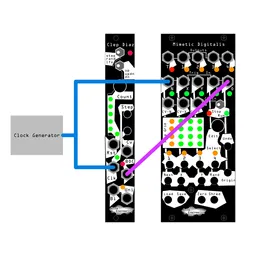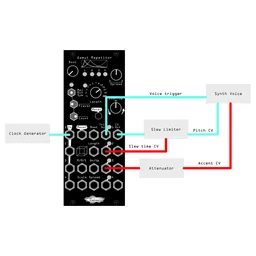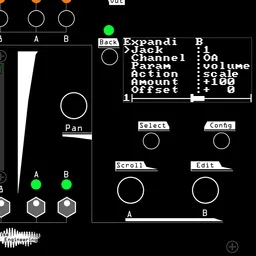Syncing sequencers with analog inputs to MIDI can be a challenge, but Univer Inter has a plethora of options to make it straightforward. Today, we’ll explore run gates and DIN Sync-style clocking to get your sequencers running how they should!
What is DIN Sync?
DIN Sync is a clocking standard introduced by Roland in the 1980s. It’s an analog clock specification that, handily, uses the same connector as DIN MIDI, but confusingly is NOT DIN MIDI and works completely differently. DIN Sync is most commonly found on sequencers, or devices with built-in sequencers like drum machines and some synthesizers. The specification defines four signals, but generally only two are used: a run signal and a clock signal. This combination is used to control the transport and tempo of a sequencer. I’ve found it to be an extremely reliable and straightforward way of clocking things.
Run and clock
DIN Sync’s main signals are a run gate and a clock pulse. The extra cool thing is that these signals are simple 5V gates (in most cases), meaning that they’re very easy to integrate with Eurorack systems.
Generally, DIN Sync clocks have a resolution of 24 PPQN, but some devices use a resolution of 48 PPQN instead. (If you’re not familiar with clocks and clock resolution, check out this blog post for all the details!)
To control transport, run gates go high a few milliseconds before the first clock pulse, stay high while the sequencer is running, then go low when the sequencer stops. Run gates differ in behavior from reset signals: many Eurorack sequencers use reset triggers to jump back to their first step, but run gates have the advantage of only using one signal to control reset, start, and stop.

Enter Univer Inter
If you’ve configured clock outs on your Univer Inter, you’ve probably noticed the extensive number of outputs there are in the sync category. For DIN Sync, we just need two: a Run output, and a 24PPQN clock. This will generate DIN Sync signals based on incoming MIDI clock (either from USB or from the TRS MIDI In jack).

We love ⅛” jacks in Eurorack, but DIN Sync lives up to its name. If you want to synchronize a drum machine or sequencer that has a DIN Sync input, you can patch the two outs of your Univer Inter into an adapter like this one made by ALM, then to your DIN Sync input:

This makes it quite easy to synchronize a DIN Sync device like a drum machine from your DAW or another MIDI device.
In the rack
Most Eurorack devices that use DIN Sync clock don’t use actual DIN jacks. Instead, they’ll have separate inputs and/or outputs for run and clock – same signals, different jacks. Some sequencers use run gates but need a lower PPQN clock than normal DIN Sync.
In my system, I’ve found that run gates are by far the easiest way to control complex sequencers, and I use them wherever I can. My XOR NerdSeq has a dedicated DIN Sync setting, so I can patch my run gate and 24 PPQN clock from UI right in and it works perfectly.
My Metron and Metropolix each use a 4 PPQN clock, but also have settings for run gate inputs, so I mult out the run gate and use a separate clock out for those. This UI config keeps everything in sync, with 5 outs free for any other tasks I may have for it:

And with a couple of mults and patch cables, all three of my sequencers run in sync with my DAW!







